SCOUTED: Using SkillCorner data to search for standouts in LaLiga2
SCOUTED uses SkillCorner data to search for standout players in Spain LaLiga 2

SkillCorner has partnered with Scouted Football, providing data and insights to support their writing on the best emerging talent in football. In this article, the Scouted team used our data to search for standout talent in LaLiga 2, with the potential to make the jump to the Spanish top flight.
The Segunda División is the single biggest market for LaLiga clubs, accounting for a significant chunk of done deals since 2020. We’ve utilised SkillCorner data to pick out players that can make the jump to the Spanish top flight before long.
Since 2020, LaLiga clubs have signed almost 100 players from the Segunda División, which lies a step beneath them in the Spanish football pyramid.
The second tier of the Spanish game, stylised as LaLiga 2, has provided like no other league, accounting for a significant chunk of players transactions every window. The deals range from up-and-coming talents to relegated stars, regular starters, as well as the odd experienced old-timer.
The past summer provided plenty of examples: Mika Mármol, a talented left-footed centre-back, earned a deserved move to Las Palmas; Levante captain Pepelu hopped across town to Valencia; Sergi Darder returned to the top flight with Mallorca, and a 33-year-old Joselu secured an unlikely loan move to Real Madrid.
Throughout the years, the Segunda División has proven to be a market that boasts plenty of value for those competing in the Spanish top flight. That’s why I’ve decided to search for the next standouts that should make the upward move before long, utilising bespoke SkillCorner data to do so.
Before I begin, I’d like to preface this piece by noting that much of it is predicated on SkillCorner data. Using data is just one part of the scouting process, but it is an extremely useful method to narrow down vast data sets and highlight the standouts within it.
The standout to end all standouts
An attacking playmaker was one of the profiles I had on my list, and when I ran the numbers to find one, the results were staggering. When I showed them to Stevie, my partner in SCOUTED crime, he sent back this on WhatsApp:
“wtf hahahhahaah whats the sample size?”
Stevie has seen plenty over the years, so it must be pretty startling to elicit a response like that. And I can confirm that the sample size is very healthy; the standout in question has played 95.4% of his side’s league minutes so far this season. Anyway, here it is…

Just look at that… look at that! When it comes to data and its visualisation, it’s rare to find a subject that jumps off the page as much as Iñigo Vicente does here. You could fit another three tiers of attacker between and the best of the rest. This is Lionel Messi type stuff. This alone should have him headlining LaLiga shortlists.
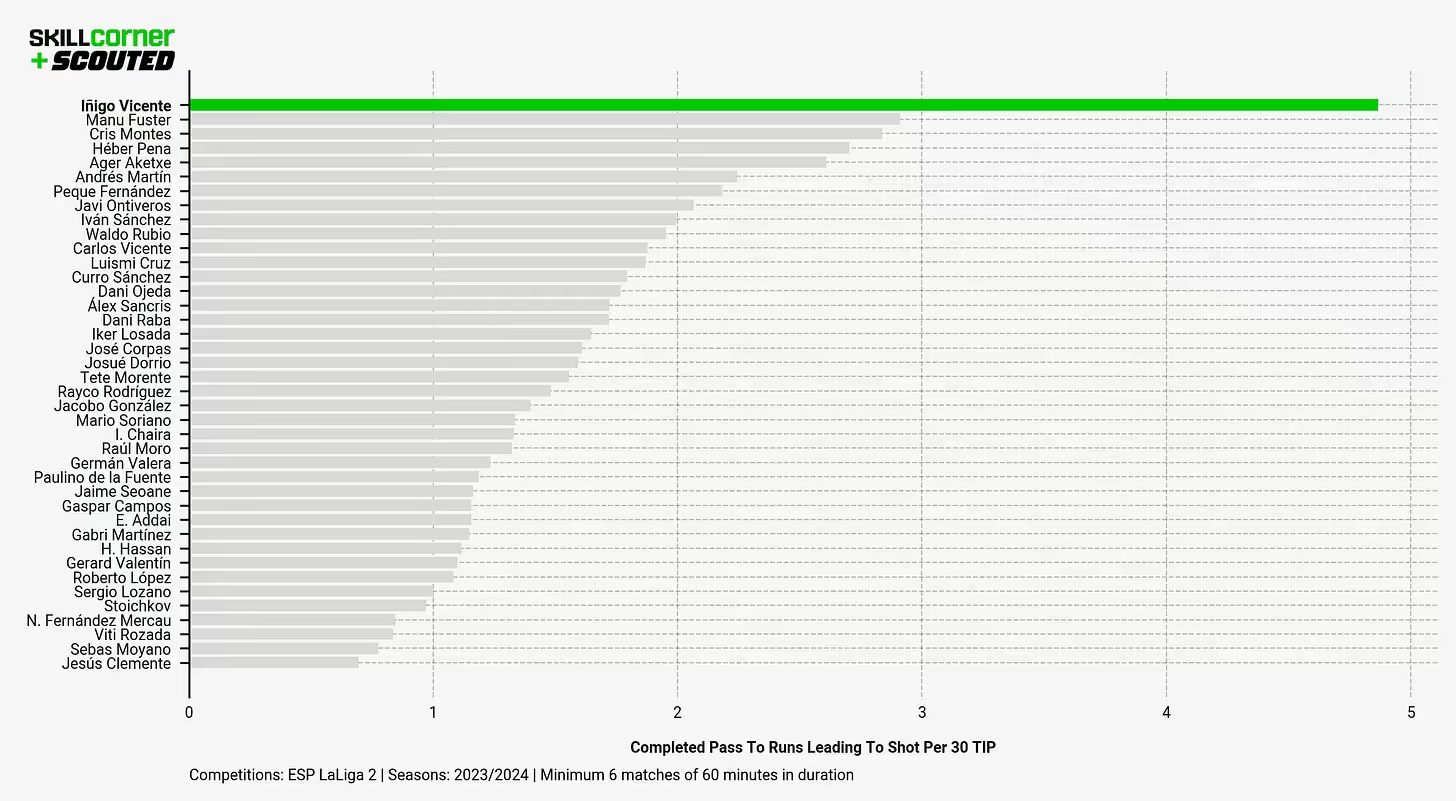
There’s another way to look at it on the SkillCorner platform. Vicente is almost doubling the next-best in this metric. Get around it.
Anyway, the attempted passes to runs x completed passes to runs leading to shots combination is a trusty one if you’re looking for a playmaker. Not only does it show the frequency with which a player seeks to create, it shows how effective they are at doing so - and Vicente does both at an explosive level.
One of the best bits about SkillCorner data is you can specify it to pinpoint passes to certain run types. That’s exactly what I’ve done in order to sketch a more detailed outline of how the Racing Santander attacker finds his team-mates.
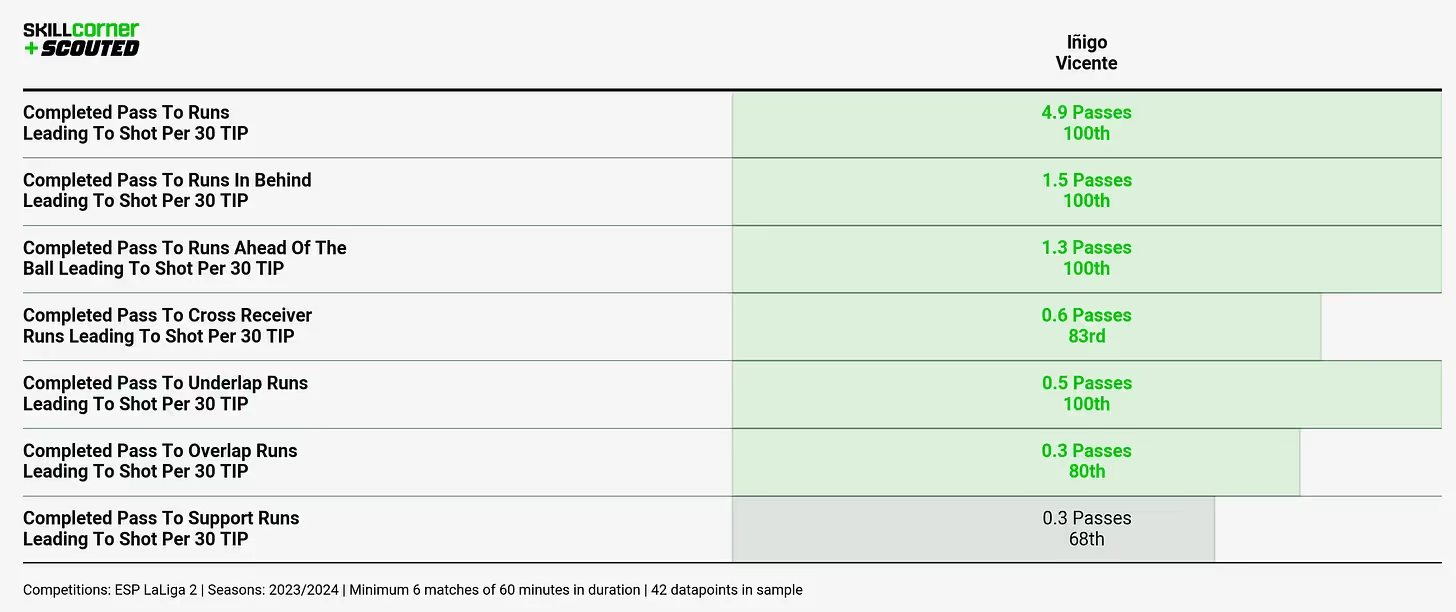
From the breakdown above, we can deduce that almost half of his exceptional production comes by playing passes into runs ahead of the ball - ‘a runner situated ahead of the ball, moving toward the opposition goal’ - and runs in behind, which is what it says on the tin.
The percentile values show just how freakishly productive Vicente has been with his passing; ranking in the 100th percentile for four different passes leading to shots is obscene — “wtf hahahahaha” is an apt response again.
Consult the video and it all tallies up: Vicente is a one-man highlight reel, playing high-value passes all the time. The bulk of them are creative balls from inside left positions, where he jags onto his excellent right foot, or around the box, where his Racing team-mates make a mishmash of dynamic off-ball movements.
A needle pass into a runner from deep? Easy. A curled cross-type ball to the far side? He can do it. A deft reverse ball into a well-timed run? A scoop pass over the top? He’s got that in the bag. His vision and technique jump off the screen, much like his data leaps off the page.
Iñigo Vicente is the best playmaking passer that the Segunda División has to offer. Hands down.
How does he stack up physically, I hear you ask? Well, that’s where SkillCorner comes in again.
Their tracking technology produces valuable physical data which provides an all-important benchmarking for traits such as speed and intensity.

To round the playmaking part off, the graph above illustrates the frequency with which Vicente attempts passes to dangerous runs by team-mates and the efficiency with which he executes them.
As we can see again, he ranks well above the Segunda average in this regard - bettered only by another Racing Santander playmaker: Gerard Fernández. What’s in the water in Cantabria?
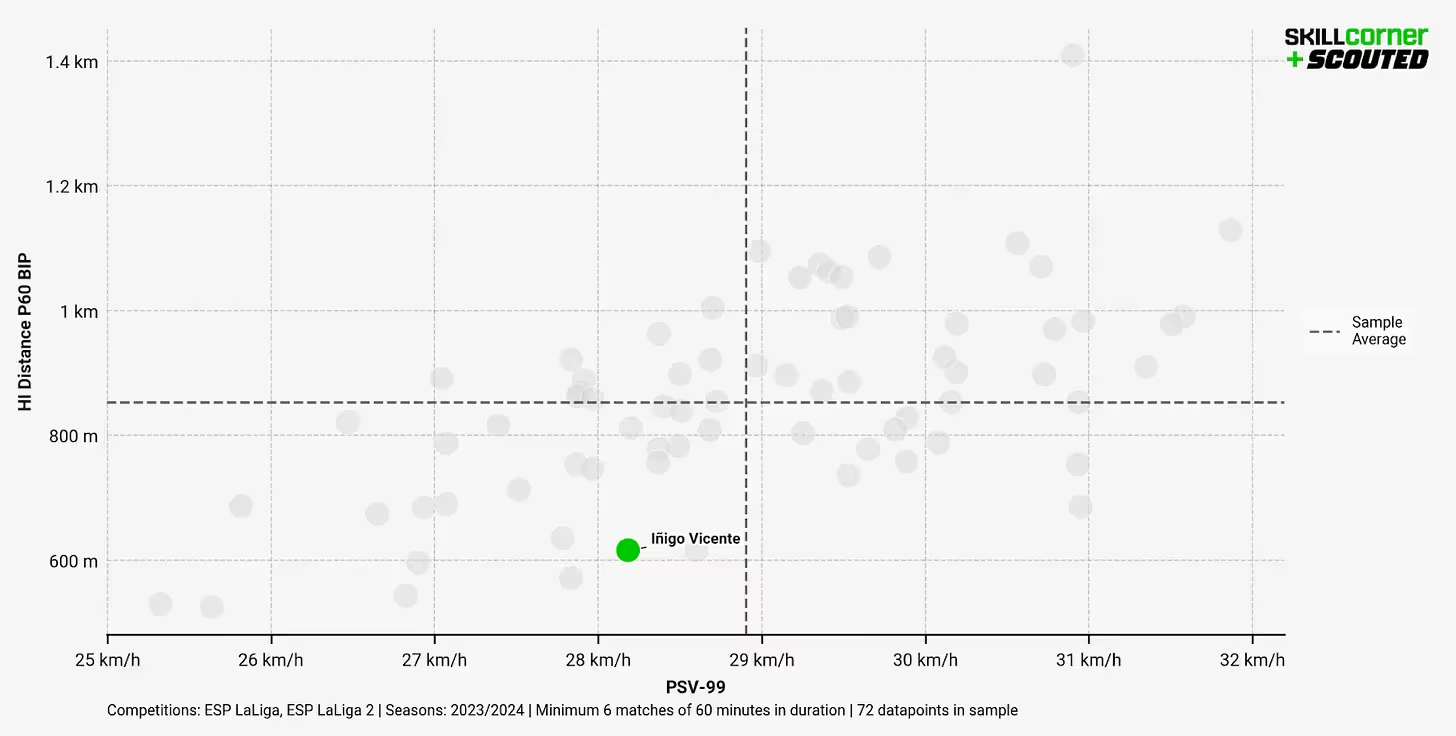
In terms of athleticism, Vicente ranks below the average among Segunda attackers in both. Pit him against attackers a level higher and he drops further again, coming in a few km/h slower than the faster - let alone the fastest - top-tier attackers. That’s something to consider when assessing how he translates to the higher level.
But as the data suggests and the video confirms, Vicente’s game doesn’t rely on straight-line speed or long-range intensity. He’s a pass-first playmaker that can carve open teams with his wicked right foot, playing what he says and often executing it.
A little bit of background on Vicente: he’s a graduate of the Athletic Club academy, where he put up some exceptional goal contribution numbers for their youth teams. This season is his fourth successive one in Segunda and second at Racing, having spent a couple on loan at CD Mirandés (more on them later…) a couple of years ago.
He’s just turned 26 years old, meaning he’s unlikely to take another leap in his development, but there’s plenty in the legs for a LaLiga move. An informed guess at a price would be about €4 million, give or take. He’s worth it.
Runs, runs, and more runs
‘If Iñigo Vicente is playing all of these passes, then who’s getting on the end of them?’ was my next question.
Thankfully, SkillCorner has the data to suggest the answer.
Out of sheer curiosity, I decided to plot all Segunda División forwards by the amount of runs they make and how many of them lead to shots. Guess who pops up, head and shoulders above his peers in both metrics…
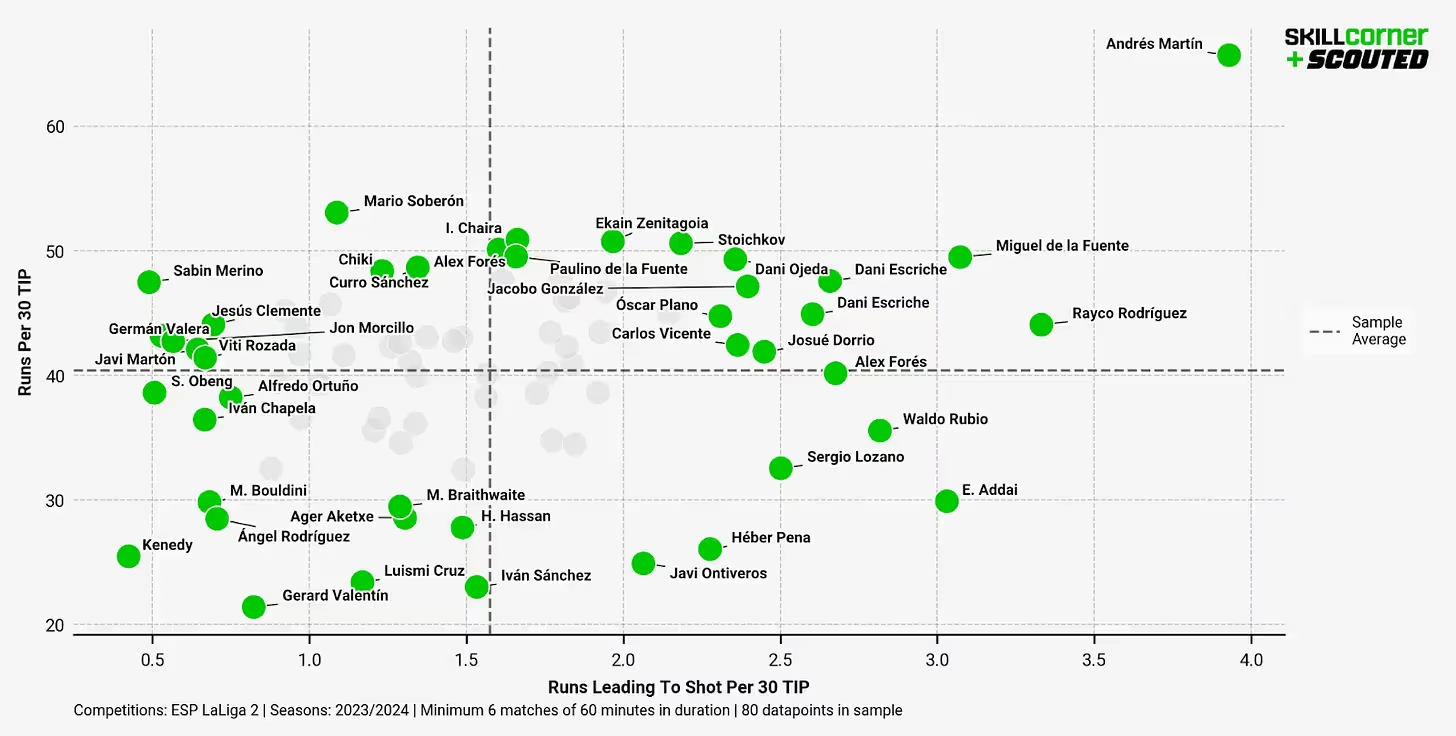
Racing Santander’s Andrés Martín, obviously. He’s the 24-year-old team-mate of Iñigo Vicente who has played 901 minutes and directly contributed to six goals in Segunda so far this season. He’s on loan from Rayo Vallecano, where he spent a couple of seasons as a regular starter in the same division at the turn of the decade.
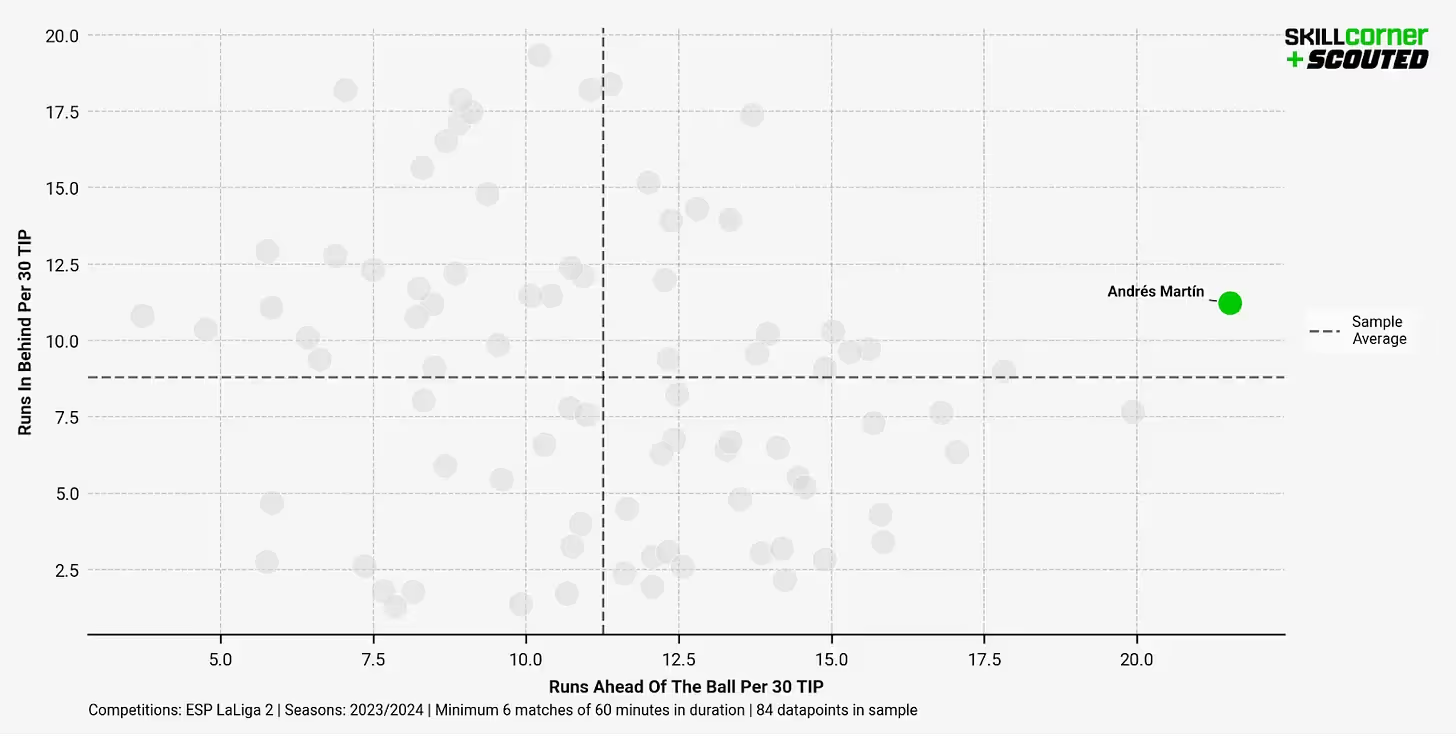
When we distil the data further, we can see that Martín makes a lot of runs ahead of the ball and in behind the defence, accounting for roughly half of his total runs. The raw quantity of them is remarkable in its own right and is indicative of the football Racing Santander play. But making them is one thing, being dangerous with them is another.

The above graphs show a couple of things, one being that Martín makes a lot of runs, but we already know that. The interesting info to derive from them is the difference in efficiency. His runs ahead of the ball are dangerous but frequent, while his runs in behind are dangerous and frequent.
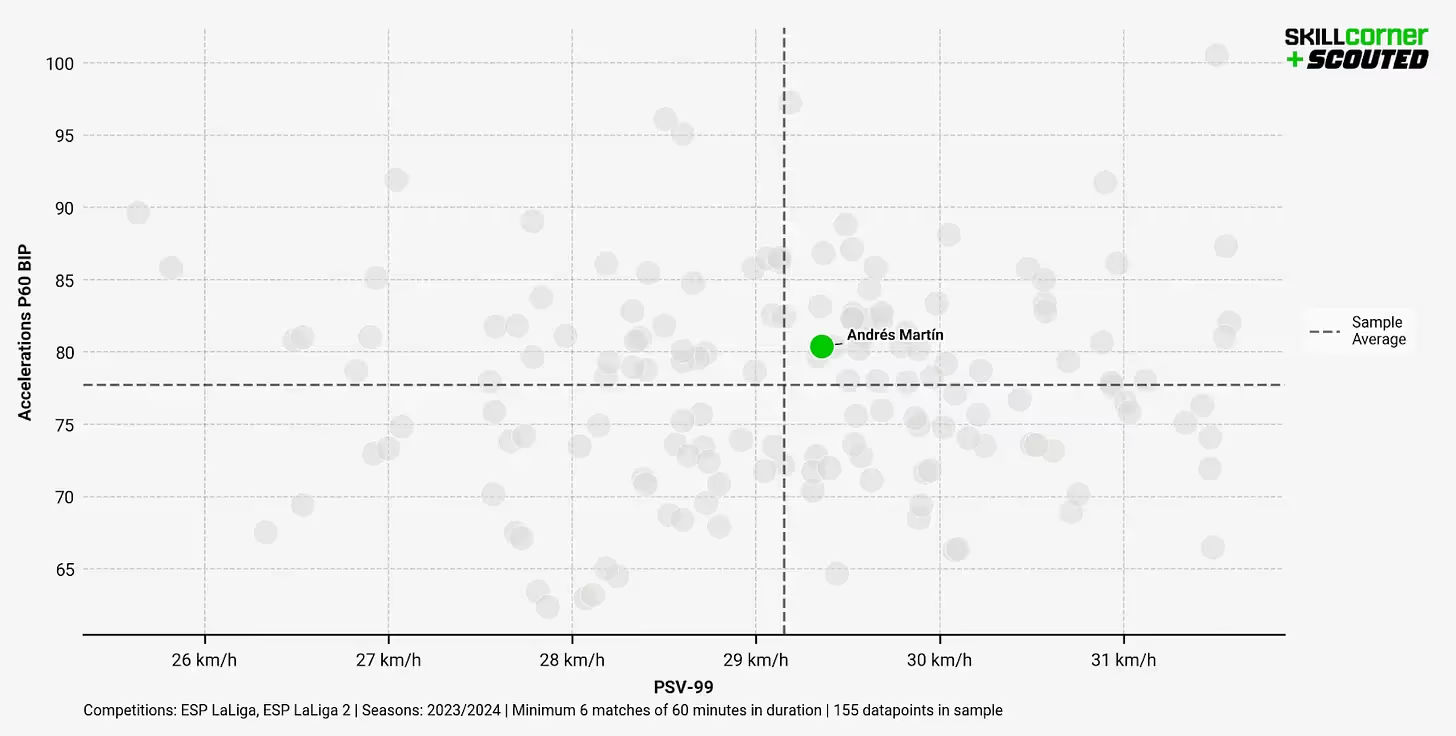
Factor in his just above-average athletic capabilities - in terms of speed and accelerations - and Martín becomes an even more interesting prospect. He regresses to pretty much the mean when you only consider LaLiga players, which is still quite impressive.
The bottomline? If you’re looking for a left-footed wide attacker that angles off the right wing and makes dangerous runs ahead of the ball and into space behind the defensive line, Andrés Martín is a strong option if you go off the data alone.
Before I move on from the Racing boys, we must consider the all-important context of team effects as well.
Racing Santander have one of the best attacks in the division - based off underlying metrics - despite average 45% possession. Factor that in with the data of Martín and Vicente shown above and it suggests they play a fast, direct, all-action style that suits attacking players.
Porting them into a different team style could pose some problems, but that’s where teams need to contextualise the data with their own talent-evaluating processes.
Made in La Masia
For much of their history, CD Mirandés have shifted between the fifth and third tiers of Spanish football - and that makes total sense. They are a modest club situated in Miranda de Erbo, a town of 35,000 people, in the northern province of Burgos, caught between the footballing powerhouses of Madrid and the Basque country.
But the past decade has yielded unparalleled success in their history, competing in the Segunda División for the most part, and it has been powered by a unique approach to squad building: they loan in a load of youngsters from LaLiga clubs.
This season’s squad features nine LaLiga loanees, and that number has been even higher in the past. A player that has broken the trend, though, is Álvaro Sanz. The deep-lying midfielder moved to Mirandés on a permanent deal a year ago and has established himself as a regular starter in Segunda.
He left his boyhood club Barcelona to do so, where he was part of a UEFA Youth League-winning side and played almost 60 times for the B team.

As you would expect from a La Masia graduate, Sanz stands out in Segunda for his security in possession. He ranks among the best in the division for retaining the ball under pressure, and his standard hardly drops even under the highest level of pressure.
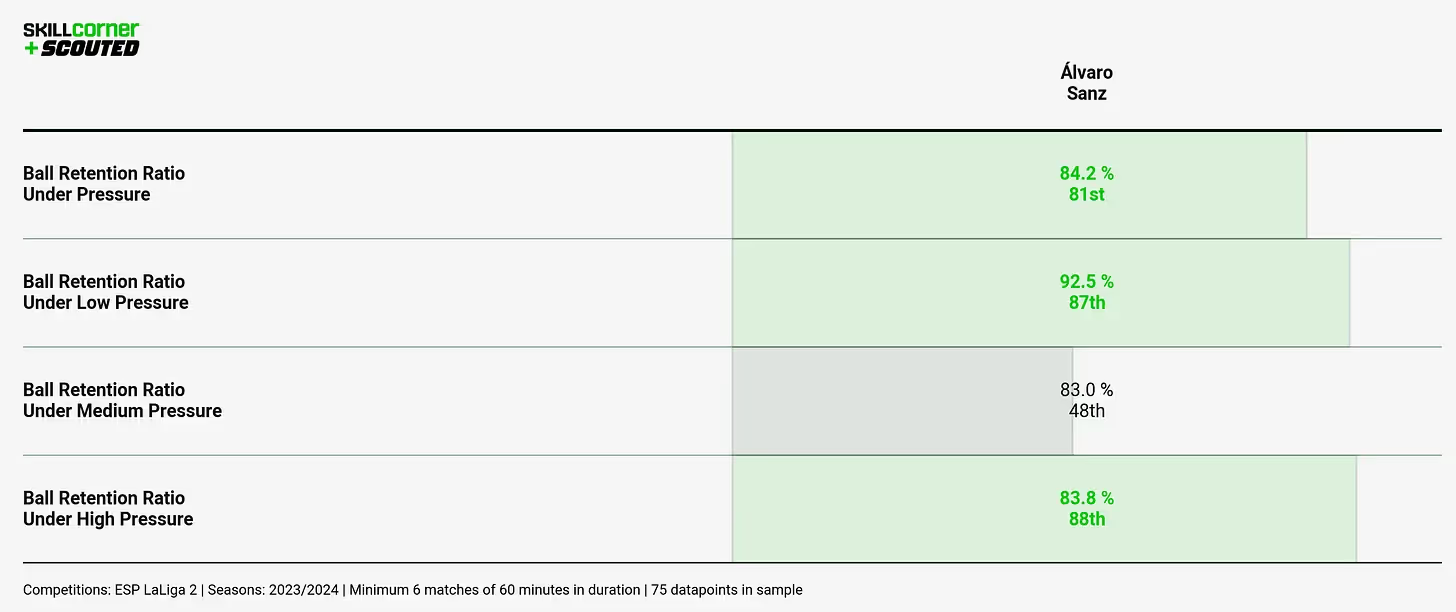
Sanz’s is pretty consistent under pressure when we break it down by intensity too, which is another boon of SkillCorner’s unique data insights. Interestingly, his quality drops under ‘medium’ pressure but bumps back up again under the highest intensity. Nevertheless, these are promising numbers for a 22-year-old in his first year of proper senior football.
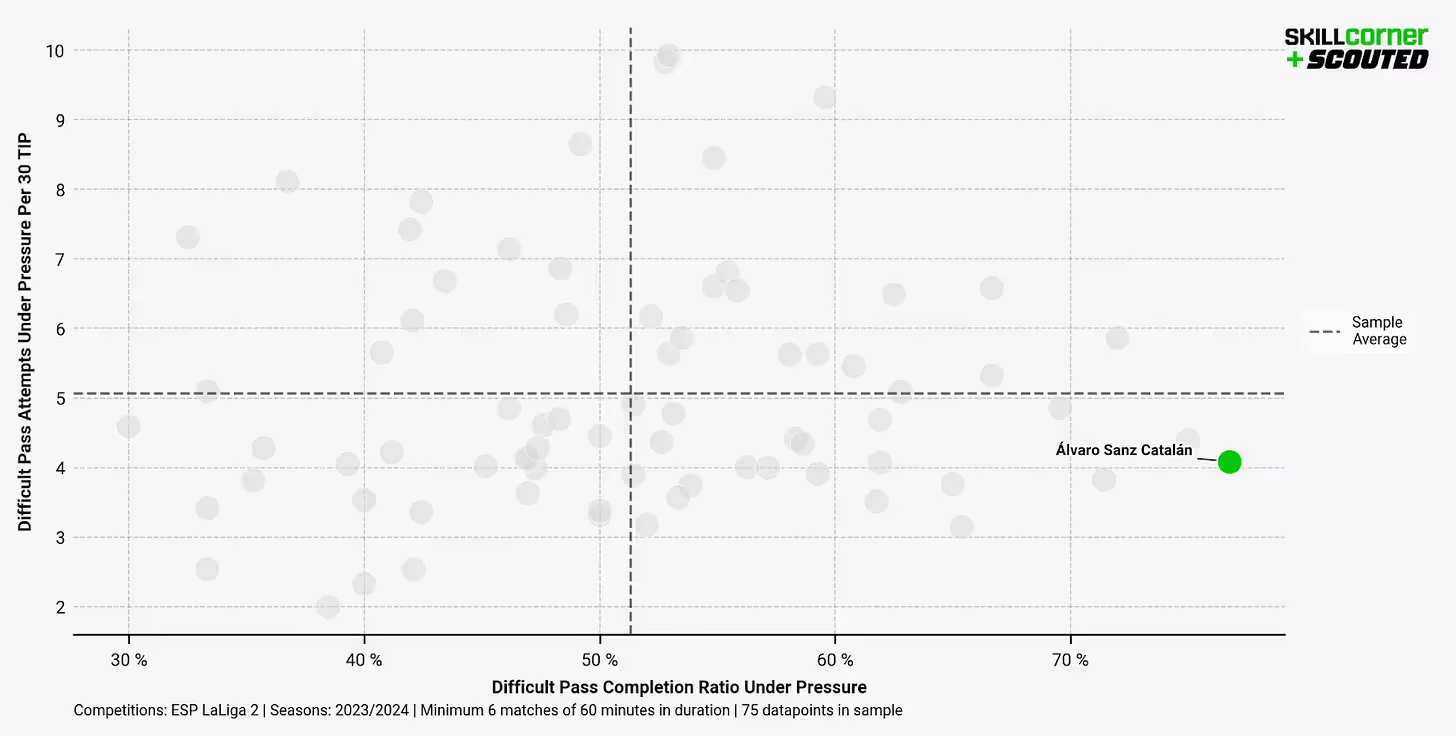
How does the 22-year-old do it? He tends to keep his passes simple under pressure. He rarely attempts a ‘difficult pass’, but he completes the vast majority of the ones he does attempt. His accuracy bumps up a few levels when put under ‘high pressure’ too, further underlining his ability to operate under duress.
Press-resistant midfielders are a valuable commodity in the modern game, and Álvaro Sanz profiles pretty well as a simple-but-secure passer from deeper areas - not least on the basis of his La Masia education. He enters the final year of his Mirandés contract this summer, making him an attainable target for clubs at the lower end of Spain’s top flight.
The final word
The Segunda División boasts plenty of value for LaLiga clubs. We knew that already, but SkillCorner’s unique data insights have further established that. A player like Iñigo Vicente, putting up numbers like he is, should be on the agenda of most of Spain’s top-flight teams.
These are just three examples, too - I could go on and find many more data standouts that are primed for a move to the Primera. The beauty of SkillCorner data offerings is you can quickly tumble down a deep rabbit hole.
Written by Llew Davies.
Click here for more information on our football products.
Click here for more of Scouted's writing on emerging football talent.

